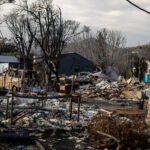North Carolina Gov. Mike Easley is requesting an additional $61 million in state funds for Western hurricane recovery efforts and urged the N.C. General Assembly to move quickly to approve the expenditure. The money will come from the state’s Rainy Day Fund and is in addition to the money Easley secured through agency cuts for this year’s disasters.
“Already, we have made hundreds of millions of dollars in aid available to communities across the state recovering from last year’s barrage of storms,” said Easley. “This additional funding is necessary in our Western counties to give communities the resources that they need to get back on their feet. We are moving quickly to ensure that citizens and local governments have the tools they need for a successful recovery.
“We have asked state agencies to tighten their belts since September and secured $90 million in funds,” said Easley. “But this additional money is needed to move recovery efforts forward. When I took office 16 months after Hurricane Floyd hit, only 19 percent of the money appropriated by the state had been allocated to communities. We learned from that experience that an incremental approach is more successful.”
The governor will leverage much of the state money to obtain federal matching funds, which helps take the strain off local governments. With these additional funds, the governor will have provided more than $150 million in state funds for western recovery, plus an additional $35 million spent to date by DOT to repair western roads and bridges, and leveraged more than $100 million in federal dollars to help with recovery.
About $16 million of the additional funds requested by the governor would be used for the State Acquisition and Relocation Fund (SARF), a program that acquires homes in the floodplain that were severely damaged or destroyed and relocates families into a comparable structure. The funds would cover about 1,000 homes.
In addition, $9 million would go to the Crisis Housing Assistance Fund (CHAF), to provide money needed for home repairs which are over and above the maximum allowed under the federal individual assistance program. The funds will cover about 1,200 homes. The governor is also developing a potential loan program that will provide additional assistance for businesses that do not qualify for other assistance.
The governor will also use the funds to provide western residents with programs put in place following Hurricane Floyd. About $8 million will be used to partially reimburse farmers for crop and equipment losses (40 percent equipment, 17 percent crops) and commercial fisheries (60 percent of their losses).
Approximately $4 million would be used to partially reimburse local government for public health expenses such as drinking water systems and sewer infrastructure while $14 million would provide additional assistance for infrastructure for local governments above the public assistance already administered by the state’s Emergency Management Division.
A total of $10 million would be placed in a contingency fund to be used for other unmet needs.
In October, Easley established a 41-member task force of diverse local representatives to identify unmet needs so the people of western North Carolina might get the assistance they needed. Their report was received by the governor’s office two weeks ago and forms the basis for much of the governor’s request.
Measures already taken by the governor to provide immediate relief to the west include the designation of Dave Kelly to spearhead recovery efforts and the January opening of the Western Redevelopment Office, which houses three staff members dedicated to serve Western citizens and communities throughout the recovery.
In addition, on Dec. 7, the governor allocated more than $90 million in state funds to leverage significant federal funding to begin the recovery efforts. Part of the money is being used to repair or replace about 250 privately owned bridges, provide funding for housing and other personal assistance for individuals and businesses that did not qualify for Small Business Administration loans, to purchase flooded homes, relocate residents, and for floodplain mapping.
With this funding, the state has repaired 90 percent of the state roads and 60 percent of private access roads and bridges in the west. This includes more than 1,250 sections of state roads and more than 200 sections of private roads. These figures also include the hundreds of small bridges on both state and private roads.
More than $6 million of the $90 million in state disaster recovery funds issued by Gov. Easley in December is being used by the N.C. Division of Emergency Management to assist property owners with the repair of private bridges and road access destroyed or damaged by the storms. All sites reported by residents have been inspected and engineering assessments completed. Sixty percent of the sites are already repaired and residents are sending the bills in for payment.
As part of the recovery, N.C. Department of Transportation crews also built seven temporary bridges and a temporary road to restore access to a dairy farm in Barnardsville. Only 10 roads out of approximately 300 remain closed due to ongoing repairs, including N.C. 215 in Haywood County, which was the location of numerous slides. Engineers anticipate opening this highway by the summer.
The governor also allocated money from the disaster recovery fund to provide the state match to the federal Emergency Watershed Protection program and the Emergency Conservation Program.
These programs restore streams and stabilize stream banks to pre-disaster conditions by removing debris, which has clogged hundreds of streams in both western and eastern North Carolina.
Was this article valuable?
Here are more articles you may enjoy.

 Zillow Deleting Climate Risk Scores Reveals Limits of Flood, Fire Data
Zillow Deleting Climate Risk Scores Reveals Limits of Flood, Fire Data  Atmospheric River to Flood Pacific Northwest Through Week
Atmospheric River to Flood Pacific Northwest Through Week  Abbott Presses Congress for Shield Over Preemie Baby Formula Litigation That Could Cost It Billions
Abbott Presses Congress for Shield Over Preemie Baby Formula Litigation That Could Cost It Billions  California Again Delays Wildfire Protection Rules for Homes
California Again Delays Wildfire Protection Rules for Homes 